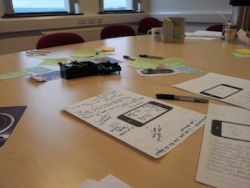Blog
Participatory Design Exercise Results
- Details
- Published: Wednesday, 22 January 2014 15:47
On the 10th of January 2014 we conducted a participatory design exercise discussing issues related to Internet collected “things” and their capabilities. The discussion was framed around a number of devices such as smart appliances, an in-car black box, a internet connected alarm clock and a smart toy.
During the discussion a number of interesting issues were identified:
- What kind of information about me is collected by devices?
- What other sources of external data are devices able to use?
- What kind of degree of control do I have on the data generated and transmitted?
- Who is using the data and for what purposes?
As part of the event we also discussed how information related to the questions above could be visualised in a mobile phone app. One of the most interesting ideas that emerged from the discussion was to characterise this information by What (what information is bing collected) Who (who is using the information) and Why (Why is the data collected e.g. for what purposes). This is a quite interesting idea for us as it aligns very well with the 7 w’s of provenance introduced by Goble [1] expanding on the Zachman Framework [2].
The 7 w’s are: Who, What, Where, Why, When, Which, & (W)How. Each of these provides a unique type of provenance information which can be used individually or in combination with others to support the assessment of trustworthiness and quality of open data. You can find further information on this topic here
- [1] C. Goble. Position statement: Musings on provenance, work ow and (semantic web) annotation for bioinformatics. Workshop on Data Derivation an Provenance, Chicago, 2002.
- [2] J. A. Zachman. A framework for information systems architecture. IBM Systems Journal, 26(3):276{292, 1987}





